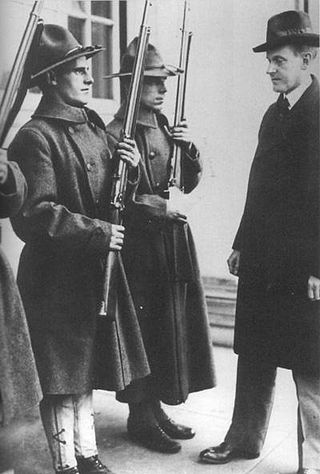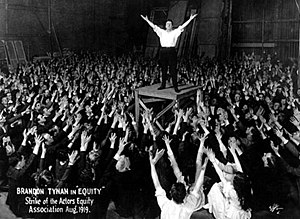
The Actors' Equity Association (AEA), commonly called Actors' Equity or simply Equity, is an American labor union representing those who work in live theatrical performance. Performers appearing in live stage productions without a book or through-storyline may be represented by the American Guild of Variety Artists (AGVA). The AEA works to negotiate quality living conditions, livable wages, and benefits for performers and stage managers. A theater or production that is not produced and performed by AEA members may be called "non-Equity".

Stage management is a broad field that is generally defined as the practice of organization and coordination of an event or theatrical production. Stage management may encompass a variety of activities including overseeing of the rehearsal process and coordinating communications among various production teams and personnel. Stage management requires a general understanding of all aspects of production and provides complete organization to ensure the process runs smoothly and efficiently.
Industrial unionism is a trade union organising method through which all workers in the same industry are organized into the same union, regardless of skill or trade, thus giving workers in one industry, or in all industries, more leverage in bargaining and in strike situations.

The One Big Union was an idea in the late 19th and early 20th centuries amongst trade unionists to unite the interests of workers and offer solutions to all labour problems.

The American Federation of Television and Radio Artists (AFTRA) was a performers' union that represented a wide variety of talent, including actors in radio and television, radio and television announcers and newspersons, singers and recording artists, promo and voice-over announcers and other performers in commercials, stunt persons and specialty acts—as the organization itself publicly stated, "AFTRA's membership includes an array of talent". On March 30, 2012, it was announced that the members of AFTRA and of the Screen Actors Guild (SAG) had voted to merge and form SAG-AFTRA.

The United Brotherhood of Carpenters and Joiners of America, often simply the United Brotherhood of Carpenters (UBC), was formed in 1881 by Peter J. McGuire and Gustav Luebkert. It has become one of the largest trade unions in the United States, and through chapters, and locals, there is international cooperation that poises the brotherhood for a global role. For example, the North American Chapter has over 520,000 members throughout the continent.
The Associated Actors and Artistes of America (4As), established in 1919, is the federation of trade unions for performing artists in the United States.

Boston police officers went on strike on September 9, 1919. They sought recognition for their trade union and improvements in wages and working conditions. Police Commissioner Edwin Upton Curtis denied that police officers had any right to form a union, much less one affiliated with a larger organization like the American Federation of Labor (AFL), which some attribute to concerns that unionized police would not protect the interest of city officials and business leaders. Attempts at reconciliation between the Commissioner and the police officers, particularly on the part of Boston's Mayor Andrew James Peters, failed.
The American Federation of Actors (AFA) was an early actors union in the United States.

The Steel Strike of 1919 was an attempt by the American Federation of Labor to organize the leading company, United States Steel, in the American steel industry. The AFL formed a coalition of 24 unions, all of which had grown rapidly during World War I. In the lead role would be the Amalgamated Association of Iron, Steel and Tin Workers (AA) with a five-member steering committee. The strike began on September 22, 1919, and finally collapsed on January 8, 1920. The opposition led by Elbert H. Gary, president of U.S. Steel had triumphed.
Canadian Actors' Equity Association (CAEA) is an association of performers in English Canada who are engaged in live performances before paying audiences in theatre, opera and dance. It negotiates agreements and working conditions for its membership, and represents about 6,000 professional artists, which includes actors, dancers, and opera singers, as well as theatre directors, choreographers, fight directors and stage managers.
The Broadway League, formerly the League of American Theatres and Producers and League of New York Theatres and Producers, is the national trade association for the Broadway theatre industry based in New York, New York. Its members include theatre owners and operators, producers, presenters, and general managers in New York and more than 250 other North American cities, as well as suppliers of goods and services to the theatre industry.
2007 Broadway Stagehands Strike was a strike action by stagehands represented by Theatrical Protective Union Number One of the International Alliance of Theatrical Stage Employees (IATSE) against the Shubert, Jujamcyn, and Nederlander theaters. The strike commenced on November 10, 2007, at 10:00 A.M. in New York City. It was the second strike on Broadway in five years.

The White Rats was a fraternal organization formed by vaudeville performers, led by George Fuller Golden, as a labor union to support the rights of male performers. Women and African-American performers were not allowed to join. The White Rats attempted to combat the monopolistic practices of the United Booking Office (UBO) and the Vaudeville Managers Association (VMA), groups formed by vaudeville theater managers to keep performers' wages low and control when and where performers were allowed to work. It was based on the Grand Order of Water Rats, a British entertainment industry fraternity and charity. It received a charter from the American Federation of Labor in 1910. The union staged several strikes but ultimately disbanded.

George Fuller Golden, was a popular vaudeville entertainer at the beginning of the 20th century. He is best known for his monologues about his fictional friend Casey. He was also a prizefighter. He was the founder of the White Rats, a labor union for vaudeville performers.

The International Longshore and Warehouse Union (ILWU) is a labor union which primarily represents dock workers on the West Coast of the United States, Hawaii, and in British Columbia, Canada. The union was established in 1937 after the 1934 West Coast Waterfront Strike, a three-month-long strike that culminated in a four-day general strike in San Francisco, California, and the Bay Area. It disaffiliated from the AFL–CIO on August 30, 2013.

The Congress of Industrial Organizations (CIO) was a federation of unions that organized workers in industrial unions in the United States and Canada from 1935 to 1955. Originally created in 1935 as a committee within the American Federation of Labor (AFL) by John L. Lewis, a leader of the United Mine Workers (UMW), and called the Committee for Industrial Organization. Its name was changed in 1938 when it broke away from the AFL. It focused on organizing unskilled workers, who had been ignored by most of the AFL unions.
The Producing Managers' Association (PMA) was a coalition of theatrical managers established on April 23, 1919. Formed in an effort to reduce conflicts between producers and theater managers and share common interests, it became the main vehicle for negotiation with the Actors' Equity Association (Equity) and Actors' Fidelity League (Fidelity) during the 1919 actors' strike.
The Actors' Fidelity League (Fidelity) was a short-lived unaffiliated American craft union representing actors who worked in live theatrical performances. It split off from Actors' Equity Association (Equity) in August 1919 when the parent organization affiliated with the American Federation of Labor (AFL) and adopted strike tactics. Fidelity approved of collective bargaining but objected to breaking contracts once signed. A few of its members objected to trade unionism itself in the belief that they were artists rather than craftsmen. Though not a company union in the traditional sense, there was some merit in Equity accusations that the League was too close to the producers.














